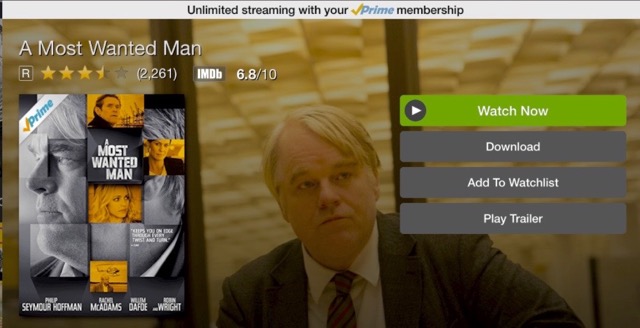You have /5 articles left.
Sign up for a free account or log in.

Earlier this month some 40 million Amazon Prime subscribers in the United States were informed of an unexpected, no-cost upgrade: Prime subscribers learned that they can now download video to their Apple and Android mobile devices, for free! Subscribers have up to 30 days to view downloaded videos – movies, documentaries, TV series, children’s shows, and more.
There is a lot to like about the new Amazon Prime download option. Much, but not all of the Amazon Prime Instant Video inventory is now available, including many “major motion pictures” plus titles from HBO (Entourage, The Wire, The Sopranos) and PBS/BBC (Downton Abbey, The Last Enemy), as well as Amazon’s own video productions including Alpha House, Beethoven on the Hudson and Transparent.
One immediate impact of the new Amazon Prime downloading option will probably be that Amazon Instant Video serials and movies will replace movies rented or purchased from iTunes and other sources as airplane entertainment on the many of the digital devices used by travelers crammed into coach seats. Too, the new downloading option for Amazon Prime will no doubt increase the pressure on both Netflix and Hulu to offer downloading for their subscribers.
This is yet another example of the technology experience in consumer market raising expectations for similar technology resources and services from colleges and universities. And for tens of thousands of students and faculty at two- and four-year institutions, the reference point has now become “why is it I can download a movie from Amazon but not the video materials from my classes?
The rising role and importance of video in instruction brings to mind Thomas Edison’s 1913 prediction about the role of motion pictures in education: "Books will soon be obsolete in the public schools. Scholars will be instructed through the eye. It is possible to teach every branch of human knowledge with the motion picture. Our school system will be completely changed in ten years.” Edison’s bold prediction is enhanced by the fact that it was offered a more than a decade ahead of the 1927 movie, The Jazz Singer, widely regarded as the first feature-length “talking” motion picture.
Although the “motion picture” has yet to supplant the book in K-12 and college courses, a century later there is no question that video content is an important component of both on-campus and online instruction. Consider the numbers on video and lecture capture from the fall 2014 Campus Computing Survey:
- 68 percent of the CIOs and senior IT officers representing 470 two- and four-year colleges and universities agreed/strongly agreed that “lecture capture is an important part of the campus plan for delivering instructional content” and is highest – 85 percent – in public universities.
- 70 percent of the institutions that participated in the fall 2014 survey reported that they provide video lecture capture services.
- CIOs and senior IT officers estimated that 28 percent of classes make some use of online video content (highest in private four-year colleges at 32 percent) and that about 7 percent of the courses at their institutions use video lecture capture (highest in public four-year colleges at 9 percent).
Ok: I can hear the comments that these numbers should not be surprising. And yes, I know: students are mobile, most have smart phones, and wireless is almost everywhere on campus and many places off-campus.
Yet I suspect that most of current campus video content is streamed, but not available for downloading. And wireless is not everywhere.
There is great convenience to having either segments or a the full 30/60/90 minute video from a challenging class session/lecture on my mobile device (laptop, phone, or tablet) as opposed to being location-dependent (my residence, my campus, or a local Starbucks) for high speed signal that provides access to video course resources.
Admittedly, enabling students to download video course resources involves more than just flipping the proverbial (digital) switch. There are technology and copyright issues that must be addressed. And copyright gets a little more complex when the content comes from third-party sources: YouTube and TED talk videos; Kahn Academy modules; materials prepared by commercial producers and educational publishers, or clips from the Sunday morning news programs.
Then too there are the “engaging lectures from Professor Wilson’s celebrated course on The Iliad and The Odyssey.” While Prof. Wilson has agreed to have her campus capture these lectures, she may not be willing to let current and (and future?) students download these acclaimed lectures.
(Sidebar: One of the more interesting stories about intellectual property and faculty self-image I’ve heard in the past 15 years involved an instructor who refused to let his institution continue to “replay” video lectures produced under an acknowledged “work for hire” agreement. He had lost fifty pounds in the years since the initial recording and was determined not going to let the world see his “former” self.)
Although the Fair Use provision of the current Copyright Law may allow faculty to show a few minutes of To Kill a Mockingbird or A Theory of Everything in their classes, Fair Use does not allow instructors or campus media personnel to upload movies or other commercial content to campus web sites for student viewing and downloading.
Amazon Prime has thrown a digital gauntlet at the feet of academe, one that again highlights the impact of consumer experiences on student expectations. Consequently the question at hand is not if but when (how soon) your institution will enable the downloading of locally captured or produced video content.
Follow me on Twitter: @digitaltweed





